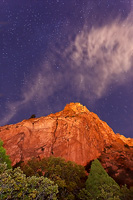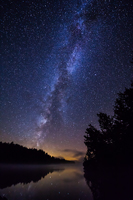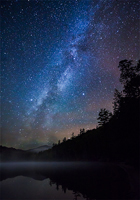I've fallen in love with shooting the night sky, especially the Milky Way galaxy. It's a milky, glowing band across the night sky, visible only in relatively dark locations away from city lights. It is estimated that the Milky Way contains between 200-400 billion stars and has a diameter of 100,000-120,000 light years! Its size is beyond comprehension. Fortunately, the latest digital camera sensors are sensitive enough to record the Milky Way in all its glory using relatively short exposures. I currently use a Canon 5D Mark II camera with a 14-24mm f/2.8 lens, shooting 30-second exposures at ISO 3200. Turning on the high ISO noise reduction feature helps in mitigating the digital noise inherent in using this high of an ISO setting.
A particularly helpful tool in predicting where the brightest parts of the Milky Way will be located in the sky at any given time and location on earth is the iPhone app called Star Walk. Armed with this tool, I can plan a shoot in advance at a time near the new moon so as to minimize light reflected from the moon which interferes with Milky Way viewing.
Click on an image for a larger view.













